Michael Collins, astronaut, dies
 Apollo 11 command module pilot Michael Collins, who remained in the command module Columbia in orbit of the moon while his crewmates, Neil Armstrong and Buzz Aldrin, landed on the moon, dies at the age of 90 after battling cancer. Upon returning to Earth, Collins opted to retire from NASA and found work within the United States government, leading to his becoming the first director of the National Air & Space Museum, a facility which had yet to open at the time he took charge of it. Collins wrote a memoir, Carrying The Fire, in 1974, one of the earliest astronaut memoirs (and the first from a member of the crew charged with making the first lunar landing). Prior to Apollo 11, he had flown with John Young aboard Gemini 10, and prior to that had distinguished careers as both a fighter pilot and a test pilot. He applied for the second group of NASA astronauts, but didn’t make the cut until NASA was recruiting its third class.
Apollo 11 command module pilot Michael Collins, who remained in the command module Columbia in orbit of the moon while his crewmates, Neil Armstrong and Buzz Aldrin, landed on the moon, dies at the age of 90 after battling cancer. Upon returning to Earth, Collins opted to retire from NASA and found work within the United States government, leading to his becoming the first director of the National Air & Space Museum, a facility which had yet to open at the time he took charge of it. Collins wrote a memoir, Carrying The Fire, in 1974, one of the earliest astronaut memoirs (and the first from a member of the crew charged with making the first lunar landing). Prior to Apollo 11, he had flown with John Young aboard Gemini 10, and prior to that had distinguished careers as both a fighter pilot and a test pilot. He applied for the second group of NASA astronauts, but didn’t make the cut until NASA was recruiting its third class.
The longest-serving astronaut retires
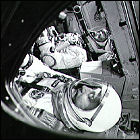 A veteran of the Gemini, Apollo and shuttle programs, 74-year-old astronaut John Young retires from NASA, capping off a 42-year career with the space agency. Young joined NASA in 1962 after hearing President Kennedy’s historic directive to launch a manned mission to the moon, and only three years later Young flew with Mercury veteran Gus Grissom on Gemini 3, the first manned two-person NASA mission. Young commanded Gemini 10 in 1966, was the command module pilot for the moon-orbiting Apollo 10 mission, and in 1972, Young commanded Apollo 16, landing in the moon’s mountainous Descartes region. Young commanded the first space shuttle mission, the maiden flight of Columbia in 1981, and commanded the ninth shuttle flight in 1983. Young had also served as the Chief Astronaut, determining crew assignments and making personnel decisions. In the wake of the Challenger disaster in 1986, Young became one of NASA’s most outspoken critics, and was reassigned to the position of special assistant for engineering, operations and safety – a move he regarded as a political one.
A veteran of the Gemini, Apollo and shuttle programs, 74-year-old astronaut John Young retires from NASA, capping off a 42-year career with the space agency. Young joined NASA in 1962 after hearing President Kennedy’s historic directive to launch a manned mission to the moon, and only three years later Young flew with Mercury veteran Gus Grissom on Gemini 3, the first manned two-person NASA mission. Young commanded Gemini 10 in 1966, was the command module pilot for the moon-orbiting Apollo 10 mission, and in 1972, Young commanded Apollo 16, landing in the moon’s mountainous Descartes region. Young commanded the first space shuttle mission, the maiden flight of Columbia in 1981, and commanded the ninth shuttle flight in 1983. Young had also served as the Chief Astronaut, determining crew assignments and making personnel decisions. In the wake of the Challenger disaster in 1986, Young became one of NASA’s most outspoken critics, and was reassigned to the position of special assistant for engineering, operations and safety – a move he regarded as a political one.
Pete Conrad, astronaut, dies
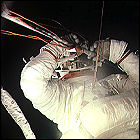 Pete Conrad, the Apollo 12 commander who was the third human to walk on the moon, dies at the age of 69 from injuries suffered in a motorcycle accident. Conrad went to the moon in November 1969, and flew two earlier Gemini missions, one of which was a new human endurance record at the time. Conrad later went on to set a new record for time spent by a human in space (28 days, unprecedented at the time) in 1973 as a member of the first Skylab crew. Conrad and fellow Skylab astronaut Joseph Kerwin performed an extended and very hazardous spacewalk to repair the station, which had been heavily damaged during launch a few weeks before its crew arrived.
Pete Conrad, the Apollo 12 commander who was the third human to walk on the moon, dies at the age of 69 from injuries suffered in a motorcycle accident. Conrad went to the moon in November 1969, and flew two earlier Gemini missions, one of which was a new human endurance record at the time. Conrad later went on to set a new record for time spent by a human in space (28 days, unprecedented at the time) in 1973 as a member of the first Skylab crew. Conrad and fellow Skylab astronaut Joseph Kerwin performed an extended and very hazardous spacewalk to repair the station, which had been heavily damaged during launch a few weeks before its crew arrived.
Deke! U.S. Manned Space From Mercury to the Shuttle
 Forge Books posthumously publishes astronaut Deke Slayton’s non-fictional memoir of his time in NASA, “Deke! U.S. Manned Space From Mercury to the Shuttle“, co-written with Michael Cassutt. The book details Slayton’s selection to the Mercury ground and his subsequent medical grounding, his time in charge of NASA’s astronaut office, and his eventual flight aboard the international Apollo-Soyuz Test Project mission.
Forge Books posthumously publishes astronaut Deke Slayton’s non-fictional memoir of his time in NASA, “Deke! U.S. Manned Space From Mercury to the Shuttle“, co-written with Michael Cassutt. The book details Slayton’s selection to the Mercury ground and his subsequent medical grounding, his time in charge of NASA’s astronaut office, and his eventual flight aboard the international Apollo-Soyuz Test Project mission.
Manned Orbital Laboratory cancelled
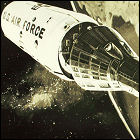 The Air Force officially cancels its plans for Manned Orbiting Laboratory, a space station in development that would have used Gemini capsules and technology to build and maintain a military outpost in space. The airmen selected as MOL crew members are transferred to NASA, where some of them will go on to fly the Space Shuttle, a vehicle whose design is still in its infancy at this point. The Air Force is also consulted on its military satellite launch needs, which are taken into account in the design of the shuttle.
The Air Force officially cancels its plans for Manned Orbiting Laboratory, a space station in development that would have used Gemini capsules and technology to build and maintain a military outpost in space. The airmen selected as MOL crew members are transferred to NASA, where some of them will go on to fly the Space Shuttle, a vehicle whose design is still in its infancy at this point. The Air Force is also consulted on its military satellite launch needs, which are taken into account in the design of the shuttle.
NASA solicits shuttle, station proposals
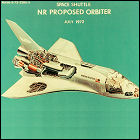 NASA formally asks various major players in the aerospace industry for proposals for what the agency sees as its two major projects for the 1970s: an orbiting space station and a reusable Space Shuttle to make routine flights from Earth to the station – which NASA hopes will be a “50 man space base” – and back again, with supplies, experiments, and new crew members. (Within mere weeks, the hypothetical station’s equally hypothetical crew will be downsized to a dozen.) In the event that the development curve on the Space Shuttle proves to be a long one, NASA says it will keep Apollo and even Gemini spacecraft in service to make flights to the station.
NASA formally asks various major players in the aerospace industry for proposals for what the agency sees as its two major projects for the 1970s: an orbiting space station and a reusable Space Shuttle to make routine flights from Earth to the station – which NASA hopes will be a “50 man space base” – and back again, with supplies, experiments, and new crew members. (Within mere weeks, the hypothetical station’s equally hypothetical crew will be downsized to a dozen.) In the event that the development curve on the Space Shuttle proves to be a long one, NASA says it will keep Apollo and even Gemini spacecraft in service to make flights to the station.
Gemini 12
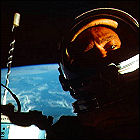 The final mission of NASA’s Gemini program, Gemini 12 lifts off with Jim Lovell and “Buzz” Aldrin aboard. Over their three-day flight, the last two-man American astronaut crew until the early Space Shuttle flights finally demonstrates improved spacewalk techniques, with handholds having been added to the Gemini capsule’s exterior, and pre-launch training conducted underwater in weighted spacesuits. Aldrin performs a two-hour spacewalk without overexerting himself, a first for the American space program. Gemini 12 splashes down, having accomplished all of the Gemini program goals mere weeks ahead of the first launch window for Apollo 1.
The final mission of NASA’s Gemini program, Gemini 12 lifts off with Jim Lovell and “Buzz” Aldrin aboard. Over their three-day flight, the last two-man American astronaut crew until the early Space Shuttle flights finally demonstrates improved spacewalk techniques, with handholds having been added to the Gemini capsule’s exterior, and pre-launch training conducted underwater in weighted spacesuits. Aldrin performs a two-hour spacewalk without overexerting himself, a first for the American space program. Gemini 12 splashes down, having accomplished all of the Gemini program goals mere weeks ahead of the first launch window for Apollo 1.
Gemini 11
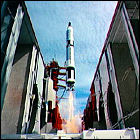 Gemini 11 lifts off on a three-day mission to continue validating rendezvous, docking and spacewalking techniques that will be needed on the upcoming Apollo lunar missions. With Pete Conrad and Dick Gordon aboard, Gemini 11 becomes the furthest manned object from Earth, using an Agena booster to push itself into a higher orbit that takes Gemini 850 miles away from Earth at its furthest point. After three days of docking, spacewalks and orbit-changing exercises, Gemini 11 returns to Earth.
Gemini 11 lifts off on a three-day mission to continue validating rendezvous, docking and spacewalking techniques that will be needed on the upcoming Apollo lunar missions. With Pete Conrad and Dick Gordon aboard, Gemini 11 becomes the furthest manned object from Earth, using an Agena booster to push itself into a higher orbit that takes Gemini 850 miles away from Earth at its furthest point. After three days of docking, spacewalks and orbit-changing exercises, Gemini 11 returns to Earth.
Gemini 10
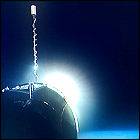 With the docking and EVA goals of the Gemini program still unmet, and with the first Apollo missions looming ahead in the mission schedule, Gemini 10 lifts off with a lot riding on it (in addition to astronauts John Young and Michael Collins). Over the course of nearly three days, the Gemini 10 crew makes up for lost time, successfully docking with an Agena booster and changing the vehicle’s orbital altitude to 188 miles – a new distance-from-Earth record for a manned spacecraft. Collins conducts two spacewalks, but the lack of handgrips on the exterior of the Gemini capsule frustrates his efforts. Gemini 10 returns after three days in space.
With the docking and EVA goals of the Gemini program still unmet, and with the first Apollo missions looming ahead in the mission schedule, Gemini 10 lifts off with a lot riding on it (in addition to astronauts John Young and Michael Collins). Over the course of nearly three days, the Gemini 10 crew makes up for lost time, successfully docking with an Agena booster and changing the vehicle’s orbital altitude to 188 miles – a new distance-from-Earth record for a manned spacecraft. Collins conducts two spacewalks, but the lack of handgrips on the exterior of the Gemini capsule frustrates his efforts. Gemini 10 returns after three days in space.
Gemini 9
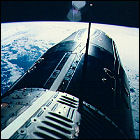 Gemini 9 lifts off on a three-day mission to complete the still unfulfilled docking objectives of the Gemini program. The flight has already seen significant problems, not the least of which is the death of the originally-assigned crew, Elliott See and Charles Bassett, in an accident involving T-38 training jets. The backup crew, Thomas Stafford and Gene Cernan, fly Gemini 9 instead, but find that their rendezvous/docking target is still trapped in the aerodynamic shroud that protected it during launch (the shroud would normally have been jettisoned). Furthermore, a spacewalk has been written into the mission plan, requiring Cernan to leave Gemini and go to the rear of the vehicle to unstow and test a “jetpack” (an early prototype of the Manned Maneuvering Unit that will finally see use in the space shuttle program in the 1980s). The spacewalk becomes a two-hour ordeal which leaves Cernan exhausted, thanks to the lack of handholds on the exterior of the Gemini capsule. The flight ends after three days in space.
Gemini 9 lifts off on a three-day mission to complete the still unfulfilled docking objectives of the Gemini program. The flight has already seen significant problems, not the least of which is the death of the originally-assigned crew, Elliott See and Charles Bassett, in an accident involving T-38 training jets. The backup crew, Thomas Stafford and Gene Cernan, fly Gemini 9 instead, but find that their rendezvous/docking target is still trapped in the aerodynamic shroud that protected it during launch (the shroud would normally have been jettisoned). Furthermore, a spacewalk has been written into the mission plan, requiring Cernan to leave Gemini and go to the rear of the vehicle to unstow and test a “jetpack” (an early prototype of the Manned Maneuvering Unit that will finally see use in the space shuttle program in the 1980s). The spacewalk becomes a two-hour ordeal which leaves Cernan exhausted, thanks to the lack of handholds on the exterior of the Gemini capsule. The flight ends after three days in space.
Gemini 8: spinning out of control
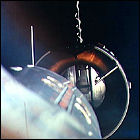 Gemini 8, carrying David Scott and Neil Armstrong, lifts off on a mission to fulfill the Agena booster rendezvous and docking goal originally assigned to Gemini 6. After docking with the Agena vehicle a few hours into the flight, Gemini 8 begins an unplanned, uncontrolled roll, and the crew initially believe it to be an issue with the Agena. But after undocking from the Agena, the Gemini capsule spins even faster out of control until Armstrong, using maneuvering thrusters reserved for reentry, cancels out the roll. Mission rules require an immediate return to Earth, and the astronauts splash down safely, barely 11 hours after liftoff.
Gemini 8, carrying David Scott and Neil Armstrong, lifts off on a mission to fulfill the Agena booster rendezvous and docking goal originally assigned to Gemini 6. After docking with the Agena vehicle a few hours into the flight, Gemini 8 begins an unplanned, uncontrolled roll, and the crew initially believe it to be an issue with the Agena. But after undocking from the Agena, the Gemini capsule spins even faster out of control until Armstrong, using maneuvering thrusters reserved for reentry, cancels out the roll. Mission rules require an immediate return to Earth, and the astronauts splash down safely, barely 11 hours after liftoff.
Gemini 6
 Delayed from its original launch date in October, Gemini 6 had been intended to be the first American space docking mission. An unmanned Agena rocket, launched ahead of Gemini 6 to serve as its docking target, had exploded during liftoff, and the October Gemini 6 mission had been scrubbed as a result. Instead, the crew of Gemini 6 – Wally Schirra and Thomas Stafford – are launched on a one-day mission to become the rendezvous target for the already-launched Gemini 7. The two manned vehicles close to within mere feet of each other – a first for human spaceflight.
Delayed from its original launch date in October, Gemini 6 had been intended to be the first American space docking mission. An unmanned Agena rocket, launched ahead of Gemini 6 to serve as its docking target, had exploded during liftoff, and the October Gemini 6 mission had been scrubbed as a result. Instead, the crew of Gemini 6 – Wally Schirra and Thomas Stafford – are launched on a one-day mission to become the rendezvous target for the already-launched Gemini 7. The two manned vehicles close to within mere feet of each other – a first for human spaceflight.
Gemini 7
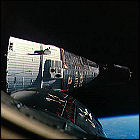 Gemini 7 is launched with Frank Borman and Jim Lovell aboard, on a grueling two-week endurance mission which also sees the first manned space rendezvous. The 14-day flight sets a new space endurance record that stands for five years – none of the lunar landing missions will last that long – and the astronauts function well throughout the flight, though some of Gemini 7’s systems begin to fray at the edges toward the end of the mission. Eleven days into Gemini 7’s flight, Gemini 6 is launched on a one-day mission to act as the rendezvous target, and the two manned vehicles close to within mere feet of each other – a first for human spaceflight.
Gemini 7 is launched with Frank Borman and Jim Lovell aboard, on a grueling two-week endurance mission which also sees the first manned space rendezvous. The 14-day flight sets a new space endurance record that stands for five years – none of the lunar landing missions will last that long – and the astronauts function well throughout the flight, though some of Gemini 7’s systems begin to fray at the edges toward the end of the mission. Eleven days into Gemini 7’s flight, Gemini 6 is launched on a one-day mission to act as the rendezvous target, and the two manned vehicles close to within mere feet of each other – a first for human spaceflight.
Gemini 5
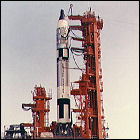 Gemini 5 lifts off on the first manned spaceflight to last over a week, breaking the previous record held by the Soviet crew of Vostok 5; the eight-day flight is crucial in proving that humans could function for the minimum amount of time that a flight to the moon and back again would take. Instead of short-lived batteries, Gemini 5 is the first American spacecraft powered by fuel cells, another important step toward longer flights to the moon. The crew consists of Gordon Cooper and Pete Conrad.
Gemini 5 lifts off on the first manned spaceflight to last over a week, breaking the previous record held by the Soviet crew of Vostok 5; the eight-day flight is crucial in proving that humans could function for the minimum amount of time that a flight to the moon and back again would take. Instead of short-lived batteries, Gemini 5 is the first American spacecraft powered by fuel cells, another important step toward longer flights to the moon. The crew consists of Gordon Cooper and Pete Conrad.
Gemini 4
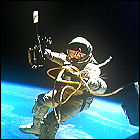 The second manned Gemini flight, Gemini 4, lifts off with Jim McDivitt and Ed White aboard for a four-day mission. Four hours into the flight, White becomes the first American spacewalker, controlling his movement with a handheld device with small jets allowing him to change his own orientation, though he is tethered to the Gemini capsule at all times. This is the first NASA flight overseen from the new Manned Space Center constructed in Houston, Texas, and the first to be broadcast live worldwide.
The second manned Gemini flight, Gemini 4, lifts off with Jim McDivitt and Ed White aboard for a four-day mission. Four hours into the flight, White becomes the first American spacewalker, controlling his movement with a handheld device with small jets allowing him to change his own orientation, though he is tethered to the Gemini capsule at all times. This is the first NASA flight overseen from the new Manned Space Center constructed in Houston, Texas, and the first to be broadcast live worldwide.
Gemini 3
 The first two-man American space crew lifts off in the first manned flight of NASA’s Gemini program. With a larger, more maneuverable spacecraft designed for longer stays in space, Gemini is intended to be a stepping stone on the path to the first lunar landing, allowing astronauts to practice rendezvous, docking, and orbital changes. Aboard the Gemini capsule are Mercury veteran Gus Grissom and rookie John Young; the capsule is unofficially nicknamed “Molly Brown” (a reference to Grissom’s sunken Mercury capsule). The flight lasts barely five hours and includes the first-ever orbital attitude changed made by a manned spacecraft.
The first two-man American space crew lifts off in the first manned flight of NASA’s Gemini program. With a larger, more maneuverable spacecraft designed for longer stays in space, Gemini is intended to be a stepping stone on the path to the first lunar landing, allowing astronauts to practice rendezvous, docking, and orbital changes. Aboard the Gemini capsule are Mercury veteran Gus Grissom and rookie John Young; the capsule is unofficially nicknamed “Molly Brown” (a reference to Grissom’s sunken Mercury capsule). The flight lasts barely five hours and includes the first-ever orbital attitude changed made by a manned spacecraft.
Manned Orbiting Laboratory
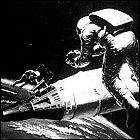 The Air Force announces the Manned Orbiting Laboratory project, a joint venture with NASA to orbit a space station using modified Gemini capsules to launch specially selected Air Force crews for month-long stays in orbit. What isn’t revealed – but isn’t too hard to figure out – is that MOL’s mission is largely military, including orbital reconaissance: the station will essentially be a manned spy satellite. The Soviet Union responds by beginning to draw up plans for its own manned military space station, Almaz.
The Air Force announces the Manned Orbiting Laboratory project, a joint venture with NASA to orbit a space station using modified Gemini capsules to launch specially selected Air Force crews for month-long stays in orbit. What isn’t revealed – but isn’t too hard to figure out – is that MOL’s mission is largely military, including orbital reconaissance: the station will essentially be a manned spy satellite. The Soviet Union responds by beginning to draw up plans for its own manned military space station, Almaz.